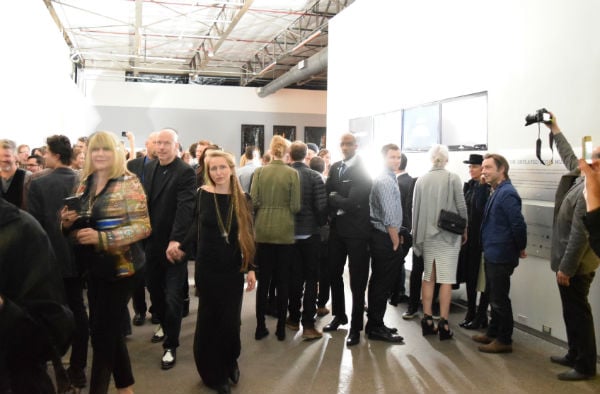Opinion
Is Loris Gréaud an Angry Chauvinist or an Art World Sociopath? Or Both?
He says that his online meltdown was an act—but that only makes it creepier.

He says that his online meltdown was an act—but that only makes it creepier.

Ben Davis

I am mildly delighted to have been in Dallas last month to have actually witnessed what is rapidly shaping up to be one of the truly great shit shows of recent art, the opening of French artist Loris Gréaud‘s “The Unplayed Notes Museum” at Dallas Contemporary.
To catch you up: This show’s opening night had a very special twist, in the form of a mysterious gang attack on the show that was choreographed by the artist and left many of his sculptures in shards. I found this bit of theater amusing (see Loris Gréaud Smashes the Mold for the Museum Shows); local critics thought less of it, with Lauren Smart penning a scathing piece for the Dallas Observer. At that point, things degenerated from art’s typical canned theoretical cocktail-party patter to its equally typical, but more often veiled, petty fury: Gréaud took to Facebook messenger to lambast Smart as unlettered in plainly sexist terms (the one-line version: he recommended that she study art history and get laid). Jezebel picked up on the fracas, and by the next day, the entire elaborately staged intellectual puzzle of “The Unplayed Notes Museum” was buried under a tidal wave of articles about a “bad boy” artist gone bad. The museum distanced itself from him.
And now, a twist on the twist: After a week behind the curtain of infamy, Gréaud has re-emerged (see Did Loris Gréaud Punk Us All with Sexist Emails?), claiming that the entire thing was just another piece in an elaborate six-part project that unfolds in stages, with his attempt to make his Dallas show the center of a media firestorm only part three. Go read Scott Indrisek’s email interview with the guy; he’s actually somewhat convincing, if in an eerie, Patrick Bateman kind of way. “I do not need to convince anybody,” he says when asked for proof. “For over a decade, I have been using rumor as a medium, word as virus, as well as disinformation and illusion according to William S. Burroughs’s ‘Electronic Revolution.’”
So, are we all dupes in Gréaud’s master plan or is this just an improbably audacious attempt to recover from a possibly career-ending mistake?
My initial take: I would be surprised if anything about this project was as neat and tidy as he is claiming now. The artist I saw in Dallas simply didn’t come off as that meticulously in control of what he was doing. As I said in my piece, the actual art in the show, except for one 2012 video piece (which comes from the François Pinault Collection, based on the photo captions), felt pretty scattershot. The idea of destroying these works certainly added a dimension of frisson. But, since the impending stunt was revealed with a self-satisfied flourish by the artist at the end of a pre-opening preview for patrons, the destruction didn’t exactly take people by surprise when it came to pass the following night. Word gets around. It felt like we were all playing along with something. You can get a sense of just how shocking and out-of-control the event felt from this picture:

The crowd during the opening for Loris Gréaud’s “The Unplayed Notes Museum,” as the works were being destroyed
Photo: Ben Davis
Still, stranger things have happened. Yves Klein once served his guests cocktails that made them pee blue.
What if we continue to play along with Gréaud now, though, just as people played along with him at the opening? Two points then are worth making. One is this: If this is what Gréaud wanted all along, then the case can be made that it makes “The Unplayed Notes Museum” worse, not better. Because, really, what kind of point is this? Punking the media is hardly a bold new art strategy, and if he thinks that some invocation of Burroughs can justify all the fuss, then he is way out of touch with contemporary culture. Accepting his story, the whole thing would be just a belabored but much less lovable version of that Jimmy Kimmel twerking video prank—and it’s no mean feat to be less lovable than Jimmy Kimmel. I tend to agree that such stunts, unless done for a reason (like the Yes Men with their attempts to impersonate and shame Dow Chemicals), are pretty lame.
But secondly, and more importantly: Let’s imagine that everything really is exactly as Gréaud claims, and Lauren Smart is just an unwilling “host for his virus” (that’s his language from the interview). If you stop to think about this for a second, that makes the entire thing much more disturbing. The underlying thought behind the piece would be, “If I send belittling and chauvinist remarks to a female art critic, can I provoke her to be so offended that she’ll post about it?” The tide of abuse that women have to put up with on the internet is no joke, and Gréaud would be joking with it—in fact, looking to capitalize off of it. We would be dealing with not the off-color outburst of a bruised ego, but calculated viciousness done in the name of advancing artistic fame.
That is a note that probably should have been left unplayed. Can anything in the coming “parts” convince me otherwise?